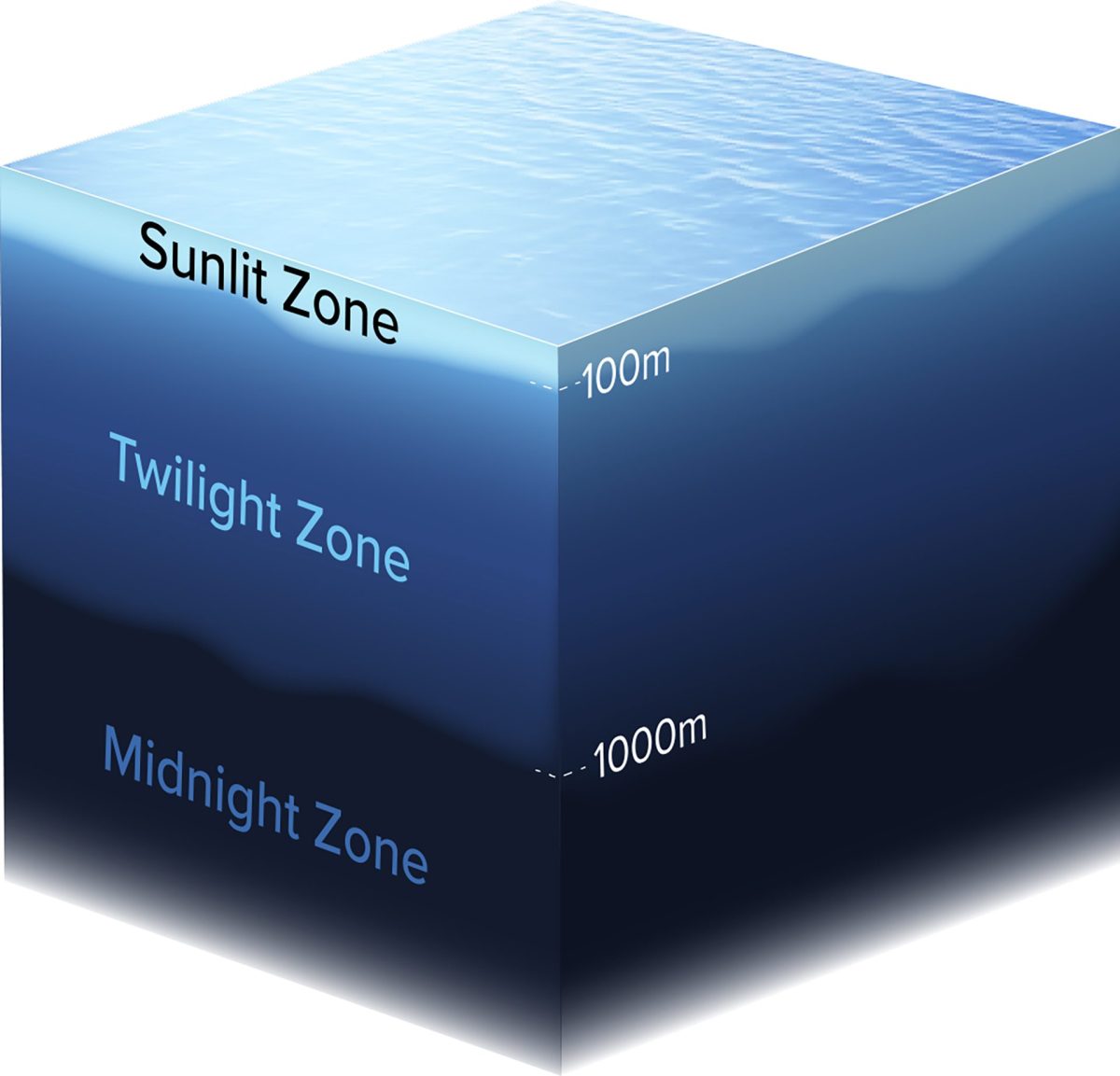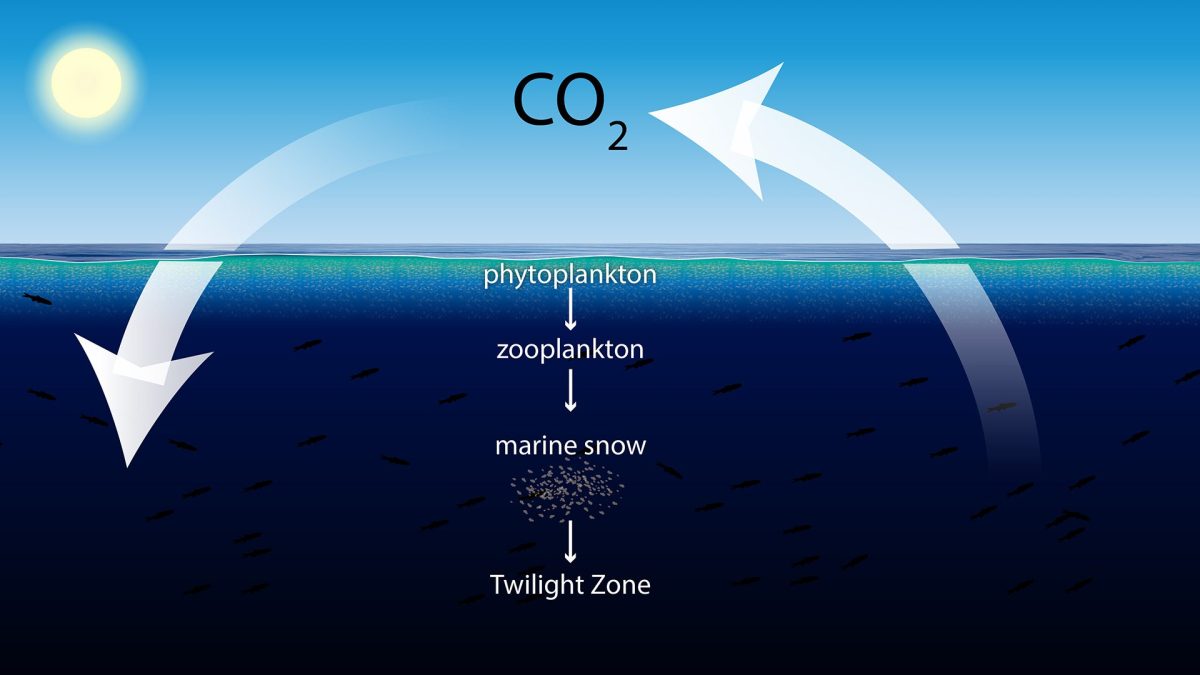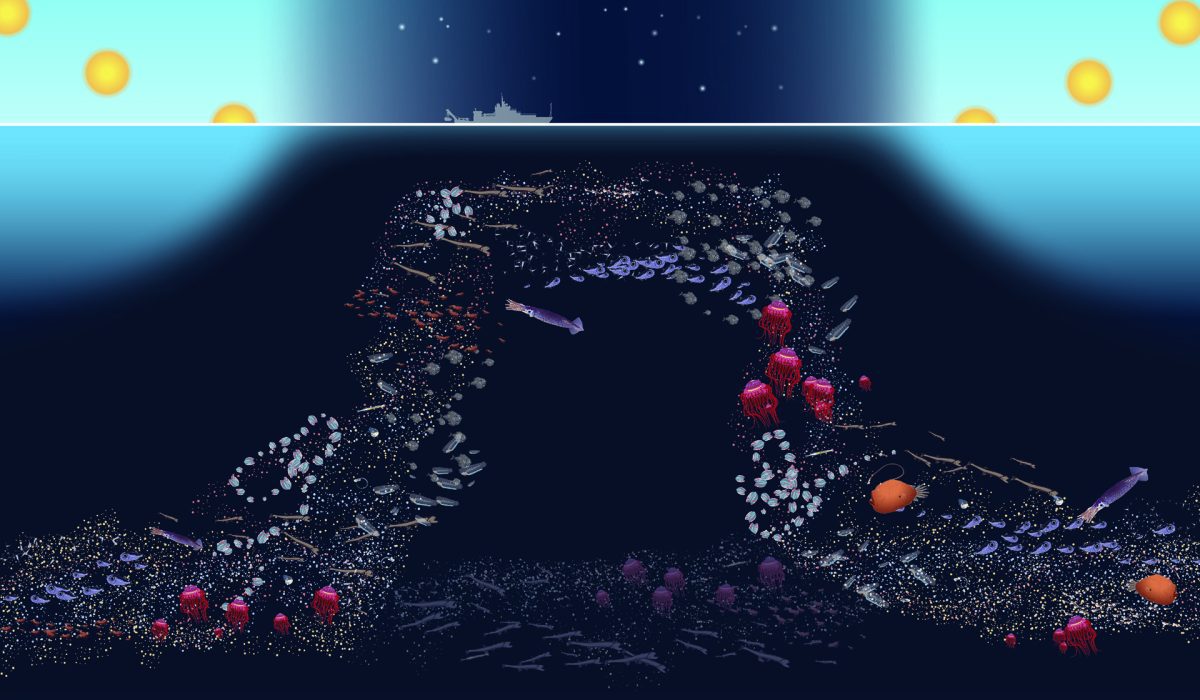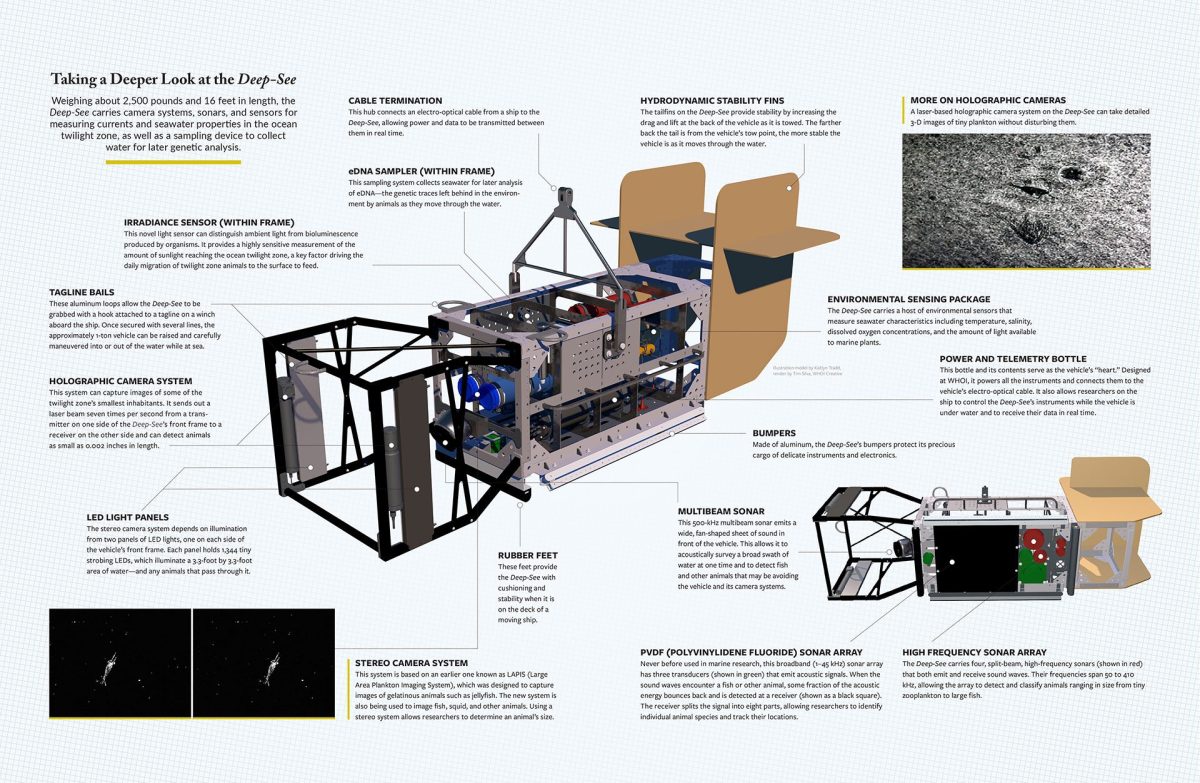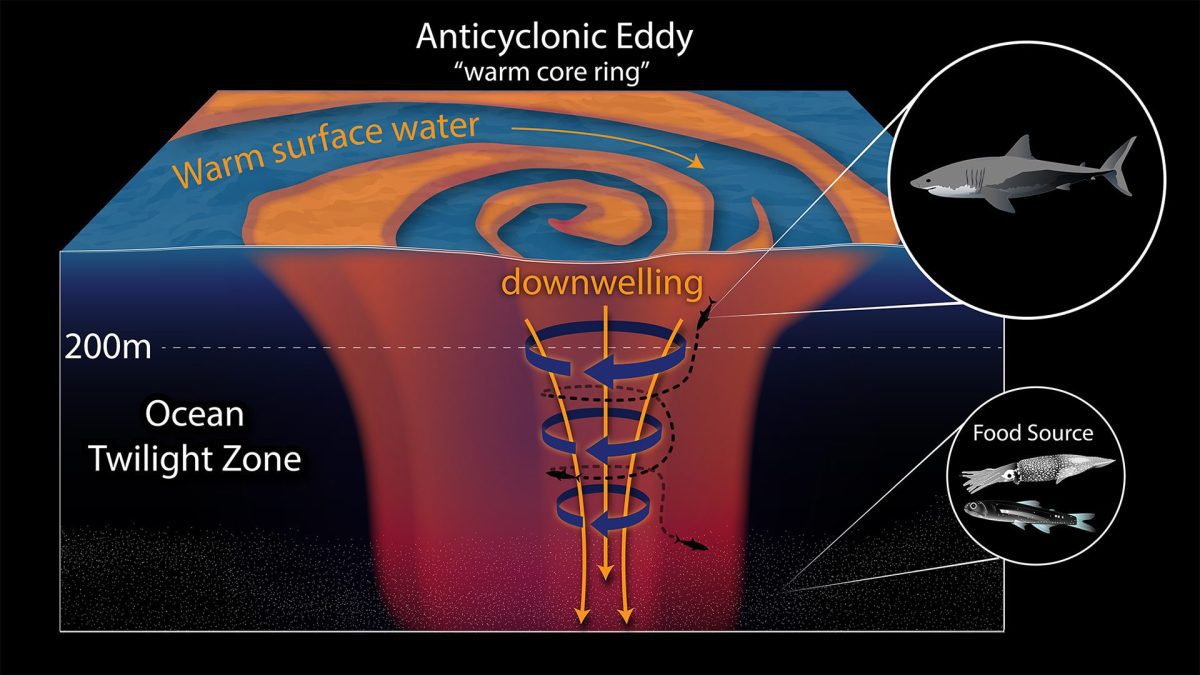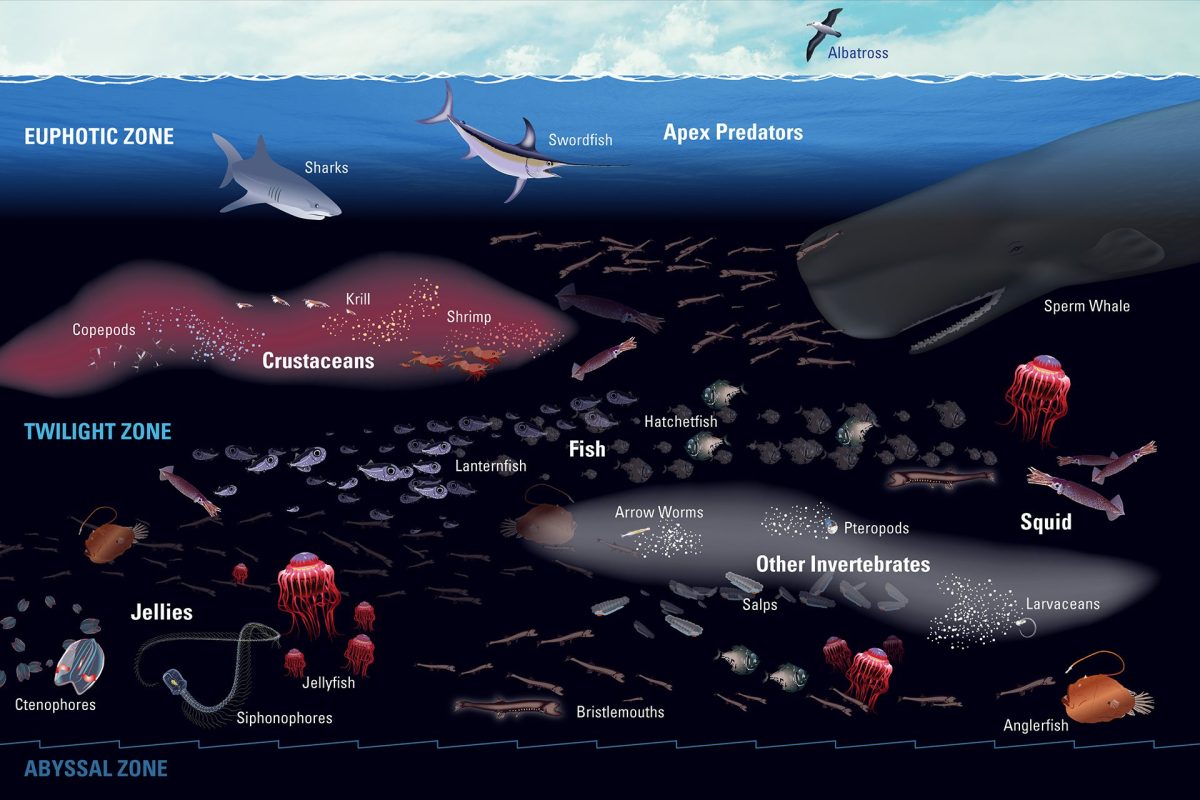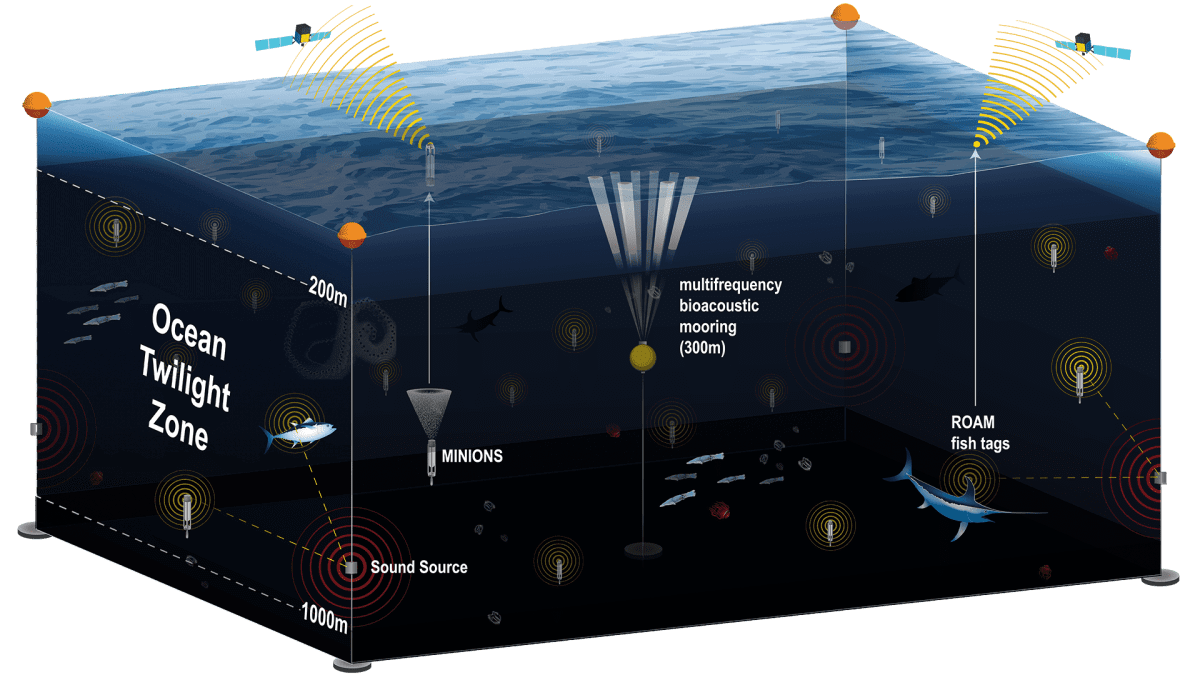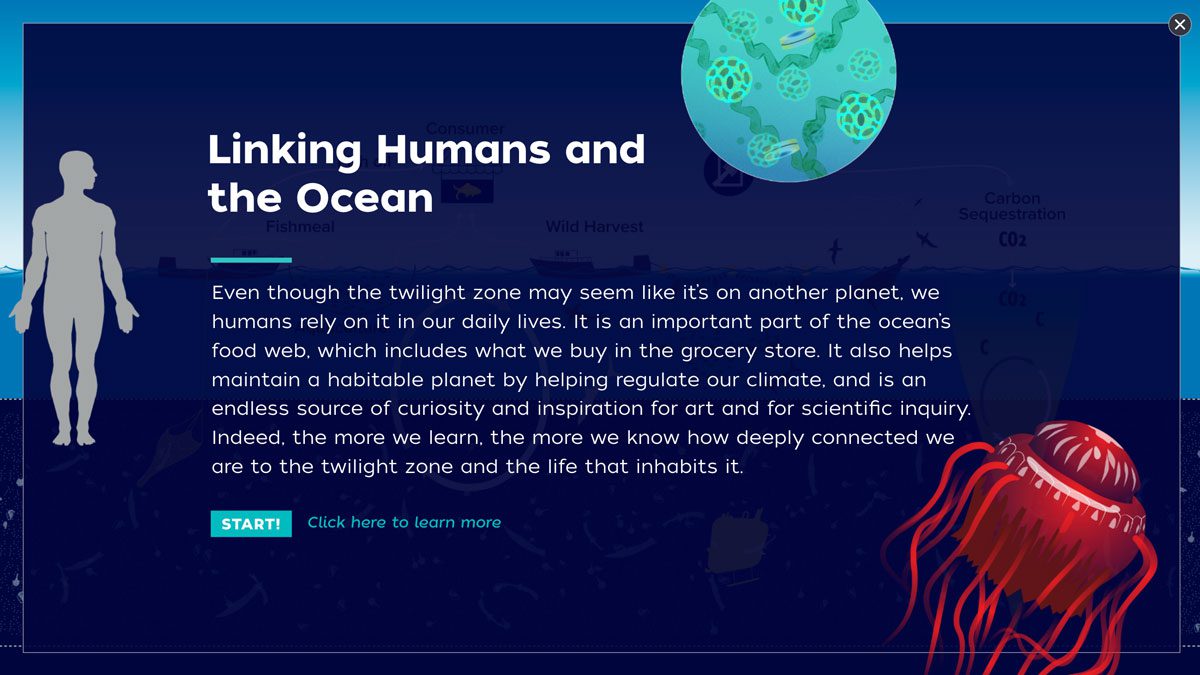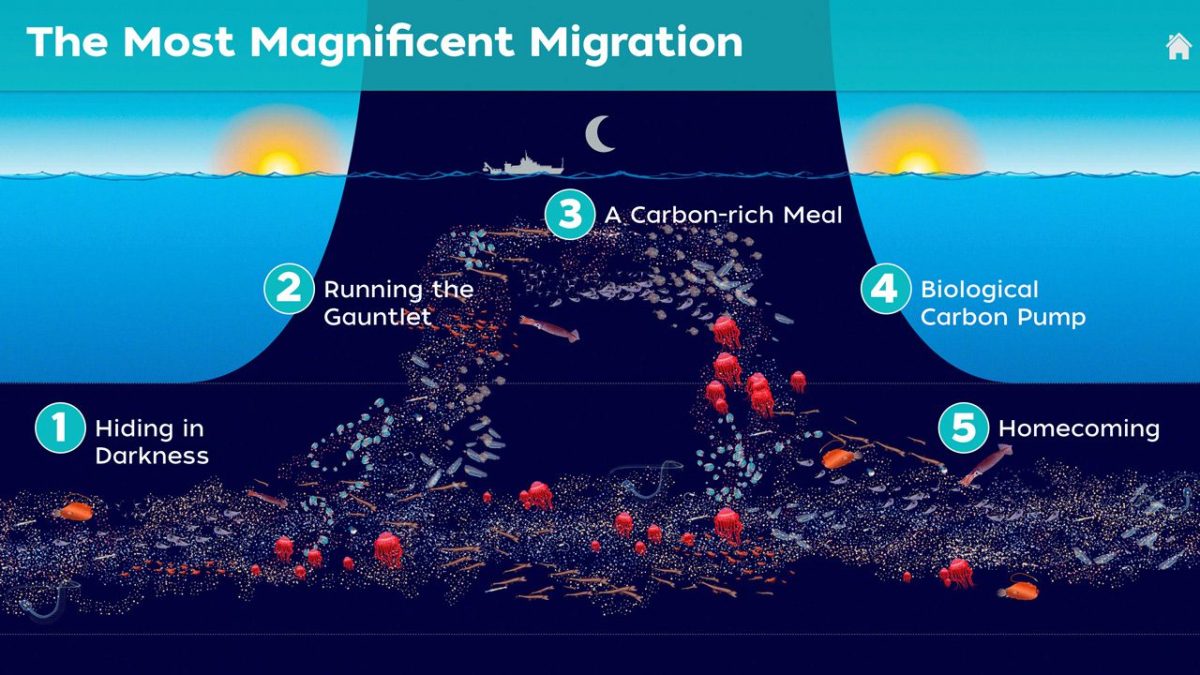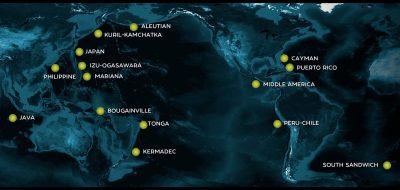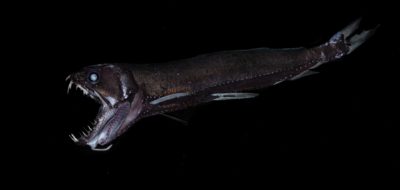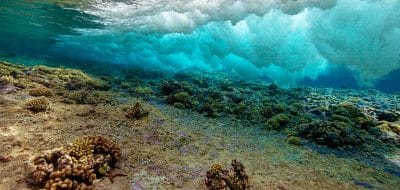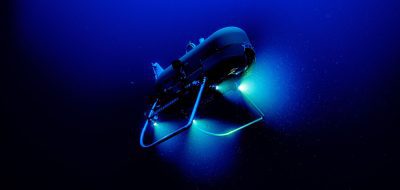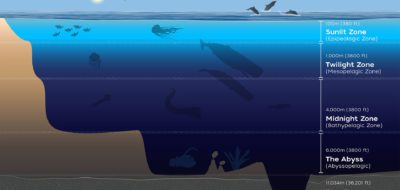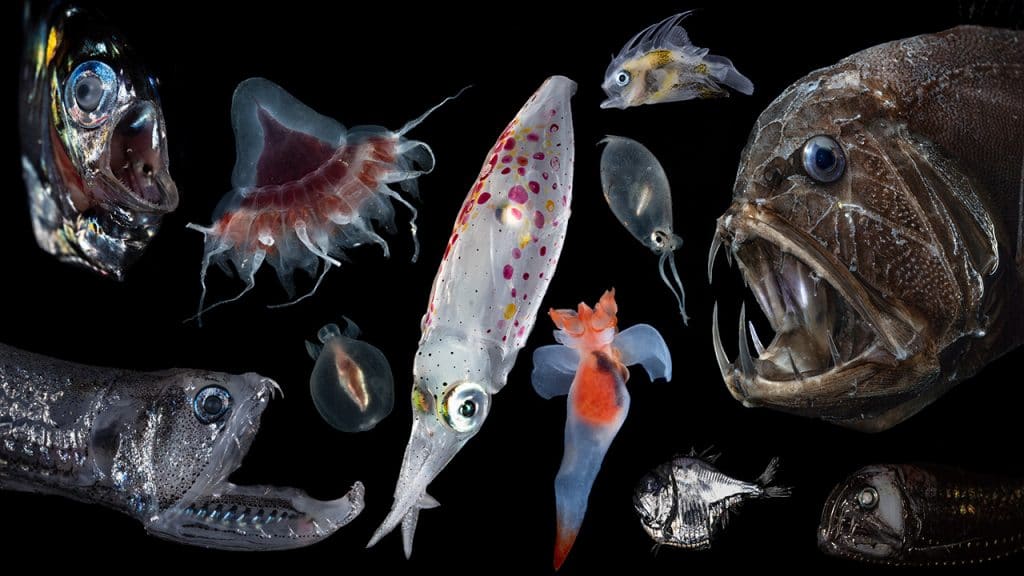
What is the ocean twilight zone?
The ocean twilight zone is a layer of water that stretches around the globe. It lies 200 to 1,000 meters (about 650 to 3,300 feet) below the ocean surface, just beyond the reach of sunlight. Also known as the midwater or mesopelagic, the twilight zone is cold and its light is dim, but with flashes of bioluminescence—light produced by living organisms. The region teems with life. Recent studies suggest that the biomass of fish in the twilight zone may be ten times greater than previously thought—more than in all the rest of the ocean combined.
Animals in the twilight zone range in size from microscopic to among the largest on the planet. Some organisms spend their lives in its shadowy depths, while others travel to and from the surface every day in the largest animal migration on Earth. Animals in the twilight zone help support the ocean’s food web and transport huge amounts of carbon from surface waters into the deep ocean, helping to regulate global climate.
So far, the twilight zone is largely unexplored and its rich biodiversity has remained mostly beyond the reach of commercial fishing—and the international laws that govern the high seas. But some fishing interests are poised to begin extracting the biological resources of the twilight zone, with unknown consequences for marine ecosystems and Earth’s climate.
What kinds of organisms live in the twilight zone?
Life in the twilight zone includes microscopic bacteria and tiny animals known as zooplankton, along with larger crustaceans, fish, squid, and many kinds of gelatinous animals. With their strange shapes and behaviors, many of the twilight zone’s inhabitants seem like the stuff of fantasy or science fiction, but they are all uniquely adapted to life in a deep, dark, watery world where temperatures stay close to freezing and water pressure can reach 1,500 pounds per square inch.
Most mesopelagic fish are only a few inches long. But their size does not keep twilight-zone animals from being a powerful force in the ocean. The bristlemouth—a small twilight-zone fish with a large jaw full of spiny teeth—is the most abundant vertebrate on Earth, possibly numbering in the quadrillions. And there are countless species still to be discovered.
To survive in such a low-light environment, many twilight-zone species—from microbes to jellies—produce their own light through a biochemical process known as bioluminescence to avoid being eaten and to attract prey.
For example, some fish use an adaptation called counterillumination to keep from being seen by potential predators. Since light in the twilight zone comes from above, many predators look up to search for prey silhouetted against the surface. Consequently, some small prey fish have rows of organs called photophores along their bellies that emit light similar in intensity and color to the light of the surface water above, making them nearly invisible when viewed from below.
Conversely, predatory fish can also use bioluminescence—in their case, to attract prey to catch and eat. Some, for example, have a bioluminescent organ called an esca that dangles from a whisker-like barbel on their chins or backs like a kind of fishing lure to tempt potential prey.
Why do some twilight-zone animals migrate?
During World War II, U.S. Navy sonar operators looking for enemy submarines were puzzled when sonar images seemed to show the seafloor changing its depth, from about a quarter mile down during the day, to near the surface after dark. What appeared to be a shifting seafloor turned out to be plankton, fish, and other twilight-zone animals making a nightly migration to and from the surface to find food.
Not all organisms in the twilight zone migrate, but many do. As darkness falls, a multitude of fish, squid, plankton, and other mid-ocean dwellers swim hundreds or even thousands of feet up to surface waters to feed under cover of darkness, then return to the relative safety of deeper, darker waters at daybreak to avoid becoming food themselves. Theirs is the largest animal migration on the planet, and it happens every 24 hours, sweeping across the world’s oceans in a massive living wave.
Why is the ocean twilight zone important?
The ocean twilight zone provides important ecosystem services, including supporting ocean food webs and commercial fisheries, and transferring carbon dioxide to the deep ocean.
How does the twilight zone support ocean food webs?
The abundance of life in the twilight zone supports a complex food web with connections to both the deep ocean and the surface. Dead animals and marine “snow”— clumps of dead plankton, bacteria, fecal pellets, and other particles rich in organic carbon—sink from surface waters through the twilight zone to the deep ocean, providing food for twilight-zone animals. Some twilight-zone inhabitants migrate to the surface to feed every night, then return to deeper waters during the day. Conversely, satellite tagging has revealed that whales, tuna, swordfish, sharks, and other top predators dive deep down into the twilight zone to feed. Since humans value those predators for their ecological, commercial, and nutritional benefits, we also depend on the twilight zone.
How does the twilight zone help keep carbon dioxide out of the atmosphere?
The ocean absorbs about a quarter of the carbon dioxide that human activities emit into the atmosphere. The twilight zone plays an important role in transferring carbon from surface water to the deep ocean, preventing it from returning into the air as a heat-trapping greenhouse gas. The multistep process is often called the ocean’s “biological pump.” In surface waters where there is plenty of light, tiny plantlike organisms called phytoplankton use energy from the sun to transform carbon dioxide into the energy and matter that allows them to grow. Phytoplankton, in turn, become food for small animals known as zooplankton, which are then eaten by fish and other animals.
Some of the carbon in surface waters becomes part of a kind of underwater blizzard known as marine snow. That “snow,” however, consists of clumps of dead plankton, bacteria, fecal pellets, and other particles rich in organic carbon, which provide food for twilight-zone animals.
Another fast track for carbon into deeper water is through the daily migration of twilight zone animals that feed near the surface at night then bring the carbon in their food back down into the twilight zone during the day.
About 90 percent of the carbon that gets into the twilight zone remains there, but a small percentage of it sinks to down into the deep ocean when animals die or expel carbon-rich fecal matter. Once there, it can remain isolated from the atmosphere for hundreds or even thousands of years.
Why do we need to find out more about the twilight zone as soon as possible?
The twilight zone’s biological richness makes it a potential source of food to support growing human populations—and an attractive future target for intensive commercial fishing operations.
Twilight zone organisms that migrate to surface waters are already being harvested on an industrial scale by the fishing fleets of countries such as Norway and Japan. Every year, factory ships are vacuuming up an ever-increasing quantity of small twilight-zone crustaceans—copepods and krill. Some of the harvest goes into fish paste for direct human consumption, but most is ground into fish meal to support expanding aquaculture or processed for use in pet foods or in “nutraceutical” oils.
Open-water fisheries far from land are currently largely unregulated, and we do not yet know enough to ensure that potential extraction of fisheries from the twilight zone would be sustainable. Nevertheless, countries including Norway and Pakistan have already issued licenses to begin fishing the twilight zone. Work began in 2018 under the United Nations Law of the Sea Convention to promote the preservation and sustainable use of marine biodiversity in areas beyond national jurisdiction, but efforts so far have focused on improving the conservation of surface-water fisheries and the genetic resources of the seabed, not of the twilight zone and its important ecosystem services, which are not well understood.
What do we still need to find out about the twilight zone?
To avoid impacts from overfishing—as has already happened with some coastal fisheries such as Northwest Atlantic cod—we need to know more about twilight zone animals and their interactions. Such information would enable policymakers to design regulations to protect twilight zone ecosystems and the surface-water species that depend on them—and also potentially allow for sustainable harvest of some twilight zone species. Among the questions still to be answered are:
- Biomass and biodiversity: What species are there, and in what quantities?
- Life histories and behaviors: How long do twilight-zone organisms live? How quickly do they grow? At what age do they reproduce?
- Food webs: To what extent do large ocean predators such as whales and tunas depend on twilight-zone organisms as a source of food?
- Global carbon cycle: How much carbon do twilight-zone animals transfer to the deep ocean through their daily migration? How much carbon sinks out of the twilight zone into deeper waters on marine snow and in other forms?
Why don’t we know more about the twilight zone?
Researchers have already learned some information about the twilight zone using acoustic imaging, nets, and submersibles. But unlike the surface ocean, which is accessible by ship and can be imaged remotely, the twilight zone isn’t easily studied with ship-based sonar and can’t be imaged with satellite technology. It covers a vast area, stretching around the globe, and changes quickly as water and animals move. Organisms in the twilight zone are unevenly distributed and are often good at avoiding nets from ships or cameras on underwater vehicles. Studying the twilight zone’s numerous gelatinous organisms such as jellyfish, salps, and siphonophores is particularly difficult, because they tend to fall apart in nets and require special lighting to be photographed or filmed.
What’s next for twilight-zone exploration and discovery?
In 2018, WHOI launched an ambitious mission to explore and understand the ocean twilight zone, with initial funding of $35 million from the Audacious Project. The effort is drawing on the expertise of a team of scientists and engineers, combining research, new technologies, and broad public engagement.
WHOI engineers are developing new platforms and vehicles that will enhance scientists’ ability to study this challenging region of the ocean. They will incorporate state-of-the art acoustics to detect twilight-zone animals, high-resolution camera systems to observe their behavior, sensors to measure environmental conditions, and sampling devices to collect small organisms and water for analysis. Researchers also will use genetic techniques and satellite tags to identify biological hot spots and better understand twilight-zone food webs.
By combining these and other new technologies with more traditional methods such as ship-based sonar and net tows, WHOI scientists and engineers hope to rapidly advance our understanding of the twilight zone and the animals living in it.

